Assyria › Kingdom of Magadha: Wars and Warfare » Origins and History
Articles and Definitions › Contents
- Assyria › Ancient History
- Kingdom of Magadha: Wars and Warfare › Antique Origins
Ancient civilizations › Historical places, and their characters
Assyria › Ancient History
Definition and Origins
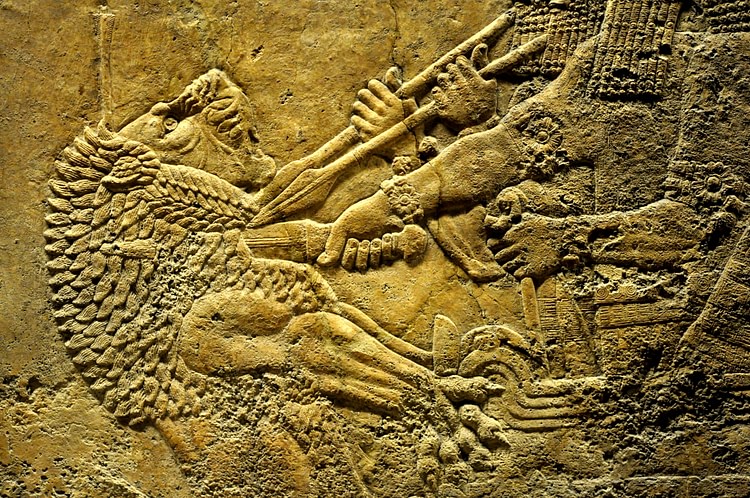
Assyria was the region located in the ancient Near East which, under the Neo-Assyrian Empire, reached from Mesopotamia (modern-day Iraq) through Asia Minor (modern Turkey ) and down through Egypt. The empire began modestly at the city of Ashur (known as Subartu to the Sumerians ), located in Mesopotamia north-east of Babylon, where merchants who traded in Anatolia became increasingly wealthy, and that affluence allowed for the growth and prosperity of the city. According to one interpretation of passages in the biblical Book of Genesis, Ashur was founded by a man named Ashur son of Shem, son of Noah, after the Great Flood, who then went on to found the other important Assyrian cities. A more likely account is that the city was named Ashur after the deity of that name sometime in the 3rd millennium BCE; the same god's name is the origin for `Assyria'. The biblical version of the origin of Ashur appears later in the historical record after the Assyrians had accepted Christianity, and so it is thought to be a re-interpretation of their early history which was more in keeping with their belief system.
The Assyrians were a Semitic people who originally spoke and wrote Akkadian before the easier to use Aramaic language became more popular. Historians have divided the rise and fall of the Assyrian Empire into three periods: The Old Kingdom, The Middle Empire, and The Late Empire (also known as the Neo-Assyrian Empire), although it should be noted that Assyrian history continued on past that point, and there are still Assyrians living in the regions of Iran and Iraq, and elsewhere, in the present day. The Assyrian Empire is considered the greatest of the Mesopotamian empires due to its expanse and the development of the bureaucracy and military strategies which allowed it to grow and flourish.
THE TRADE COLONY OF KARUM KANESH WAS AMONG THE MOST LUCRATIVE CENTRES FOR TRADE IN THE ANCIENT NEAR EAST.
THE OLD KINGDOM
Although the city of Ashur existed from the 3rd millennium BCE, the extant ruins of that city date to 1900 BCE which is now considered the date the city was founded. According to early inscriptions, the first king was Tudiya, and those who followed him were known as “kings who lived in tents” suggesting a pastoral, rather than urban, community. Ashur was certainly an important centre of commerce even at this time, however, even though its precise form and structure is unclear. The king Erishum I built the temple of Ashur on the site in c. 1900/1905 BCE, and this has come to be the accepted date for the founding of an actual city on the site although, obviously, some form of city must have existed there prior to that date. The historian Wolfram von Soden writes,
Because of a dearth of sources, very little is known of Assyria in the third millennium…Assyria did belong to the Empire of Akkad at times, as well as to the Third Dynasty of Ur. Our main sources for this period are the many thousand Assyrian letters and documents from the trade colonies in Cappadocia, foremost of which was Kanesh (modern Kultepe) (49-50).
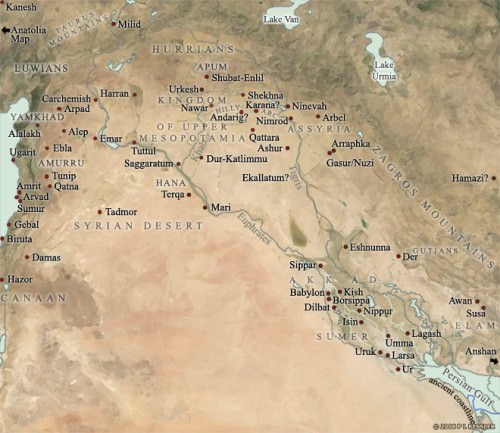
Map of Mesopotamia, 2000-1600 BC
The trade colony of Karum Kanesh (the Port of Kanesh) was among the most lucrative centres for trade in the ancient Near East and definitely the most important for the city of Ashur. Merchants from Ashur traveled to Kanesh, set up businesses, and then, after placing trusted employees (usually family members) in charge, returned to Ashur and supervised their business dealings from there. The historian Paul Kriwaczek notes:
For several generations the trading houses of Karum Kanesh flourished, and some became extremely wealthy – ancient millionaires. However not all business was kept within the family. Ashur had a sophisticated banking system and some of the capital that financed the Anatolian trade came from long-term investments made by independent speculators in return for a contractually specified proportion of the profits. There is not much about today's commodity markets that an old Assyrian would not quickly recognize (214-215).
THE RISE OF ASHUR
The wealth generated from trade in Karum Kanesh provided the people of Ashur with the stability and security necessary for the expansion of the city and so laid the foundation for the rise of the empire. Trade with Anatolia was equally important in providing the Assyrians with raw materials from which they were able to perfect the craft of iron working. The iron weapons of the Assyrian military would prove a decisive advantage in the campaigns which would conquer the entire region of the Near East. Before that could happen, however, the political landscape needed to change. The people known as the Hurrians and the Hatti held dominance in the region of Anatolia, and Ashur, to the north in Mesopotamia, remained in the shadow of these more powerful civilizations. In addition to the Hatti, there were the people known as the Amorites who were steadily settling in the area and acquiring more land and resources. The Assyrian king Shamashi Adad I (1813-1791 BCE) drove the Amorites out and secured the borders of Assyria, claiming Ashur as the capital of his kingdom. The Hatti continued to remain dominant in the region until they were invaded and assimilated by the Hittites in c. 1700. Long before that time, however, they ceased to prove as major a concern as the city to the southwest which was slowly gaining power: Babylon. The Amorites were a growing power in Babylon for at least 100 years when the Amorite king named Sin Muballit took the throne, and, in c. 1792 BCE, his son King Hammurabi ascended to rule and subjugated the lands of the Assyrians. It is around this same time that trade between Ashur and Karum Kanesh ended, as Babylon now rose to prominence in the region and took control of trade with Assyria.
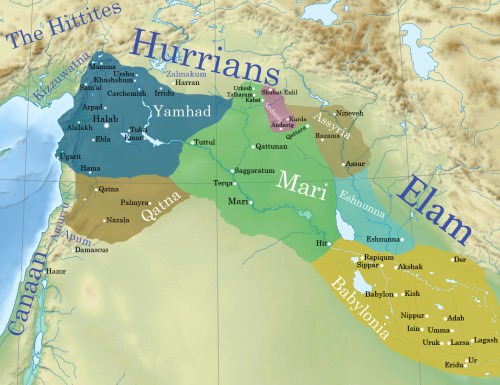
Ancient Syro-Mesopotamia ca. 1764 BCE
Soon after Hammurabi's death in 1750 BCE, the Babylonian Empire fell apart. Assyria again attempted to assert control over the region surrounding Ashur, but it seems as though the kings of this period were not up to the task. Civil war broke out in the region, and stability was not regained until the reign of the Assyrian king Adasi (c. 1726-1691 BCE). Adasi was able to secure the region and his successors continued his policies but were unable or unwilling to engage in expansion of the kingdom.
THE MIDDLE EMPIRE
The vast Kingdom of Mitanni rose from the area of eastern Anatolia and now held power in the region of Mesopotamia;Assyria fell under their control. Invasions by the Hittites under King Suppiluliuma I broke Mitanni power and replaced the kings of Mitanni with Hittite rulers at the same time that the Assyrian king Eriba Adad I was able to gain influence at the Mitanni (now mainly Hittite) court. The Assyrians now saw an opportunity to assert their own autonomy and began to expand their kingdom outward from Ashur to the regions previously held by the Mitanni. The Hittites struck back and were able to hold the Assyrians at bay until the king Ashur-Uballit I (c.1353-1318 BCE) defeated the remaining Mitanni forces under the Hittite commanders and took significant portions of the region. He was succeeded by two kings who maintained what had been won, but no further expansion was achieved until the coming of King Adad Nirari I (c. 1307-1275 BCE) who expanded the Assyrian Empire to the north and south, driving out the Hittites and conquering their major strongholds.
ADAD NIRARI I IS THE FIRST ASSYRIAN KING ABOUT WHOM ANYTHING IS KNOWN WITH CERTAINTY.
Adad Nirari I is the first Assyrian king about whom anything is known with certainty, because he left inscriptions of his achievements which have survived mostly intact. Further, letters between the Assyrian king and the Hittite rulers have also survived and make it clear that, initially, the Assyrian rulers were not taken seriously by those of other nations in the region until they proved themselves too powerful to resist. The historian Will Durant comments on the rise of the Assyrian Empire writing :
If we should admit the imperial principle – that it is good, for the sake of spreading law, security, commerce and peace, that many states should be brought, by persuasion or force, under the authority of one government – then we should have to concede to Assyria the distinction of having established in western Asia a larger measure and area of order and prosperity than that region of the earth had ever, to our knowledge, enjoyed before (270).
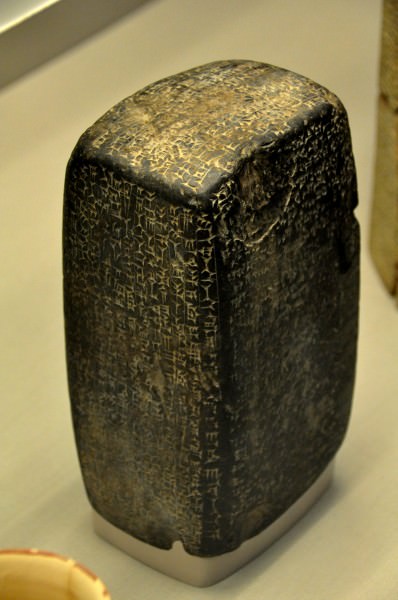 STONE FOUNDATION DOCUMENT OF KING ADAD-NIRARI I
STONE FOUNDATION DOCUMENT OF KING ADAD-NIRARI I

THE ASSYRIAN DEPORTATION POLICY
Adad Nirari I completely conquered the Mitanni and began what would become standard policy under the Assyrian Empire: the deportation of large segments of the population. With Mitanni under Assyrian control, Adad Nirari I decided the best way to prevent any future uprising was to remove the former occupants of the land and replace them with Assyrians. This should not be understood, however, as a cruel treatment of captives. Writing on this, the historian Karen Radner states,
The deportees, their labour and their abilities were extremely valuable to the Assyrian state, and their relocation was carefully planned and organised. We must not imagine treks of destitute fugitives who were easy prey for famine and disease: the deportees were meant to travel as comfortably and safely as possible in order to reach their destination in good physical shape. Whenever deportations are depicted in Assyrian imperial art, men, women and children are shown travelling in groups, often riding on vehicles or animals and never in bonds.There is no reason to doubt these depictions as Assyrian narrative art does not otherwise shy away from the graphic display of extreme violence (1).
Deportees were carefully chosen for their abilities and sent to regions which could make the most of their talents. Not everyone in the conquered populace was chosen for deportation and families were never separated. Those segments of the population that had actively resisted the Assyrians were killed or sold into slavery, but the general populaces became absorbed into the growing empire and were thought of as Assyrians. The historian Gwendolyn Leick writes of Adad Nirari I that,
the prosperity and stability of his reign allowed him to engage in ambitious building projects, building city walls and canals and restoring temples (3).
He also provided a foundation for empire upon which his successors would build.
ASSYRIAN CONQUEST OF MITANNI & THE HITTITES
His son and successor Shalmaneser I completed the destruction of the Mitanni and absorbed their culture. Shalmaneser I continued his father's policies, including the relocation of populations, but his son, Tukulti-Ninurta I (c. 1244-1208 BCE), went even further. According to Leick, Tukulti- Ninurta I,
...was one of the most famous Assyrian soldier kings who campaigned incessantly to maintain Assyrian possessions and influence. He reacted with spectacular cruelty to any sign of revolt (177).
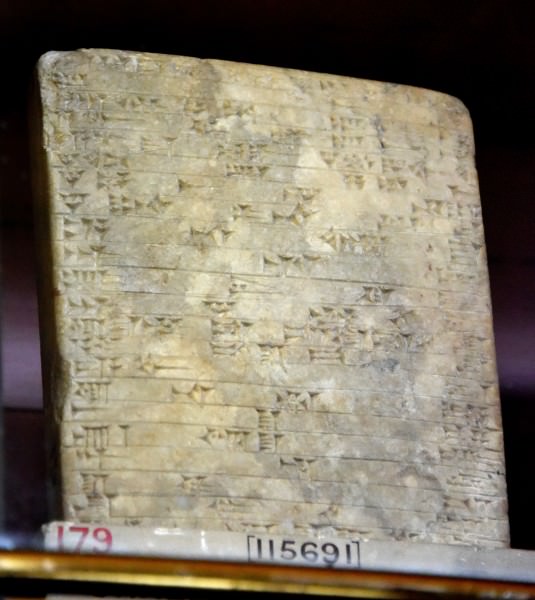
Stela of Shalmaneser I
He was also very interested in acquiring and preserving the knowledge and cultures of the peoples he conquered and developed a more sophisticated method of choosing which sort of individual, or community, would be relocated and to which specific location. Scribes and scholars, for example, were chosen carefully and sent to urban centers where they could help catalogue written works and help with the bureaucracy of the empire. A literate man, he composed the epic poem chronicling his victory over the Kassite king of Babylon and subjugation of that city and the areas under its influence and wrote another on his victory over the Elamites. He defeated the Hittites at the Battle of Nihriya in c. 1245 BCE which effectively ended Hittite power in the region and began the decline of their civilization. When Babylon made incursions into Assyrian territory, Tukulti-Ninurta I punished the city severely by sacking it, plundering the sacred temples, and carrying the king and a portion of the populace back to Assur as slaves. With his plundered wealth, he renovated his grand palace in the city he had built across from Assur, which he named Kar-Tukulti-Ninurta, to which he seems to have retreated once the tide of popular opinion turned against him. His desecration of the temples of Babylon was seen as an offense against the gods (as the Assyrians and Babylonians shared many of the same deities) and his sons and court officials rebelled against him for putting his hand on the goods of the gods. He was assassinated in his palace, probably by one of his sons, Ashur-Nadin-Apli, who then took the throne.
TIGLATH PILESER I & REVITALIZATION
Following the death of Tukulti-Ninurta I, the Assyrian Empire fell into a period of stasis in which it neither expanded nor declined. While the whole of the Near East fell into a 'dark age' following the so-called Bronze Age Collapse of c. 1200 BCE, Ashur and its empire remained relatively intact. Unlike other civilizations in the region which suffered a complete collapse, the Assyrians seem to have experienced something closer to simply a loss of forward momentum. The empire certainly cannot be said to have 'stagnated', because the culture, including the emphasis on military campaign and the value of conquest, continued; however, there was no significant expansion of the empire and civilization as it was under Tukulti-Ninurta I.
This all changed with the rise of Tiglath Pileser I to the throne (reigned c. 1115-1076 BCE). According to Leick:
He was one of the most important Assyrian kings of this period, largely because of his wide-ranging military campaigns, his enthusiasm for building projects, and his interest in cuneiform tablet collections. He campaigned widely in Anatolia, where he subjugated numerous peoples, and ventured as far as the Mediterranean Sea. In the capital city, Assur, he built a new palace and established a library, which held numerous tablets on all kinds of scholarly subjects. He also issued a legal decree, the so-called Middle Assyrian Laws, and wrote the first royal annals. He was also one of the first Assyrian kings to commission parks and gardens stocked with foreign and native trees and plants (171).
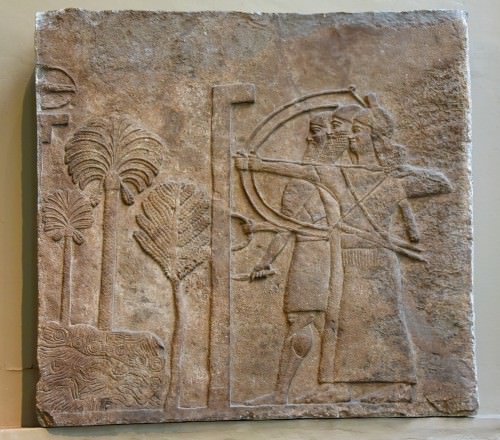
Babylonia under Assyrian Siege
Tiglath Pileser I revitalized the economy and the military through his campaigns, adding more resources and skilled populations to the Assyrian Empire. Literacy and the arts flourished, and the preservation initiative the king took regarding cuneiform tablets would serve as the model for the later ruler, Ashurbanipal ’s, famous library at Nineveh. Upon Tiglath Pileser I's death, his son, Asharid-apal-ekur, took the throne and reigned for two years during which time he continued his father's policies without alteration. He was succeeded by his brother Ashur-bel-Kala who initially reigned successfully until challenged by a usurper who threw the empire into civil war. Although the rebellion was crushed and the participants executed, the turmoil allowed certain regions that had been tightly held by Assyria to break free and among these was the area known as Eber Nari (modern day Syria, Lebanon, and Israel ), which had been particularly important to the empire because of the well-established sea ports along the coast. The Aramaeans now held Eber Nari and began making incursions from there into the rest of the empire. At this same time, the Amorites of Babylon and the city of Mari asserted themselves and tried to break the hold of the empire. The kings who followed Ashur-bel-Kala (among them, Shalmaneser II and Tiglath Pileser II) managed to maintain the core of the empire around Ashur but were unsuccessful in re-taking Eber Nari or driving the Aramaeans and Amorites completely from the borders. The empire steadily shrank through repeated attacks from outside and rebellions from within and, with no king strong enough to revitalize the military, Assyria again entered a period of stasis in which they held what they could of the empire together but could do nothing else.
THE NEO-ASSYRIAN EMPIRE
The Late Empire (also known as the Neo-Assyrian Empire) is the one most familiar to students of ancient history as it is the period of the largest expansion of the empire. It is also the era which most decisively gives the Assyrian Empire the reputation it has for ruthlessness and cruelty. The historian Kriwaczek writes:
Assyria must surely have among the worst press notices of any state in history. Babylon may be a byname for corruption, decadence and sin but the Assyrians and their famous rulers, with terrifying names like Shalmaneser, Tiglath-Pileser, Sennacherib, Esarhaddon and Ashurbanipal, rate in the popular imagination just below Adolf Hitler and Genghis Khan for cruelty, violence, and sheer murderous savagery (208).
This reputation is further noted by the historian Simon Anglim and others. Anglim writes:
While historians tend to shy away from analogies, it is tempting to see the Assyrian Empire, which dominated the Middle East from 900-612 BC, as a historical forebear of Nazi Germany: an aggressive, murderously vindictive regime supported by a magnificent and successful war machine. As with the German army of World War II, the Assyrian army was the most technologically and doctrinally advanced of its day and was a model for others for generations afterwards. The Assyrians were the first to make extensive use of iron weaponry [and] not only were iron weapons superior to bronze, but could be mass-produced, allowing the equipping of very large armies indeed (12).
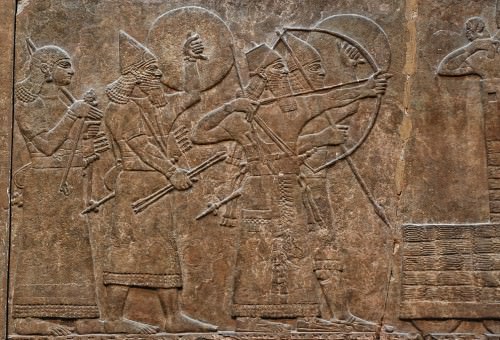
Assyrian Siege
While the reputation for decisive, ruthless, military tactics is understandable, the comparison with the Nazi regime is less so.Unlike the Nazis, the Assyrians treated the conquered people they relocated well (as already addressed above) and considered them Assyrians once they had submitted to central authority. There was no concept of a 'master race' in Assyrian policies; everyone was considered an asset to the empire whether they were born Assyrian or were assimilated into the culture. Kriwaczek notes, “In truth, Assyrian warfare was no more savage than that of other contemporary states. Nor, indeed, were the Assyrians notably crueler than the Romans, who made a point of lining their roads with thousands of victims of crucifixion dying in agony” (209). The only fair comparison between Germany in WWII and the Assyrians, then, is the efficiency of the military and the size of the army, and this same comparison could be made with ancient Rome.
THE RISE OF THE KING ADAD NIRARI II (C. 912-891 BCE) BROUGHT THE KIND OF REVIVAL ASSYRIA NEEDED.
These massive armies still lay in the future, however, when the first king of the Neo-Assyrian Empire came to power. The rise of the king Adad Nirari II (c. 912-891 BCE) brought the kind of revival Assyria needed. Adad Nirari II re-conquered the lands which had been lost, including Eber Nari, and secured the borders. The defeated Aramaeans were executed or deported to regions within the heartland of Assyria. He also conquered Babylon but, learning from the mistakes of the past, refused to plunder the city and, instead, entered into a peace agreement with the king in which they married each other's daughters and pledged mutual loyalty. Their treaty would secure Babylon as a powerful ally, instead of a perennial problem, for the next 80 years.
MILITARY EXPANSION & THE NEW VIEW OF THE GOD
The kings who followed Adad Nirari II continued the same policies and military expansion. Tukulti Ninurta II (891-884 BCE) expanded the empire to the north and gained further territory toward the south in Anatolia, while Ashurnasirpal II (884-859 BCE) consolidated rule in the Levant and extended Assyrian rule through Canaan. Their most common method of conquest was through siege warfare which would begin with a brutal assault on the city. Anglim writes:
More than anything else, the Assyrian army excelled at siege warfare, and was probably the first force to carry a separate corps of engineers…Assault was their principal tactic against the heavily fortified cities of the Near East. They developed a great variety of methods for breaching enemy walls: sappers were employed to undermine walls or to light fires underneath wooden gates, and ramps were thrown up to allow men to go over the ramparts or to attempt a breach on the upper section of wall where it was the least thick. Mobile ladders allowed attackers to cross moats and quickly assault any point in defences. These operations were covered by masses of archers, who were the core of the infantry. But the pride of the Assyrian siege train were their engines.These were multistoried wooden towers with four wheels and a turret on top and one, or at times two, battering rams at the base (186).
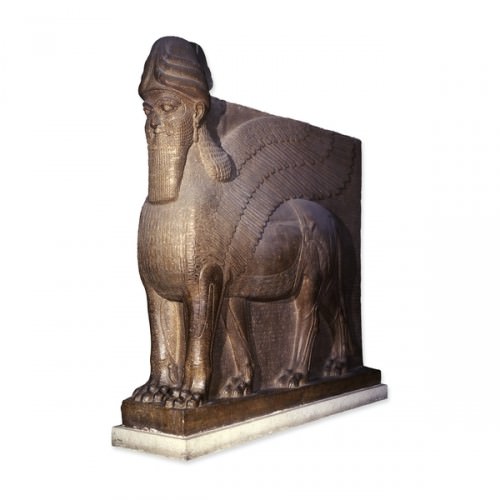
Colossal statue of a winged lion from the North-West Palace of Ashurnasirpal II
Advancements in military technology were not the only, or even the primary, contribution of the Assyrians as, during this same time, they made significant progress in medicine, building on the foundation of the Sumerians and drawing on the knowledge and talents of those who had been conquered and assimilated. Ashurnasirpal II made the first systematic lists of plants and animals in the empire and brought scribes with him on campaign to record new finds. Schools were established throughout the empire but were only for the sons of the wealthy and nobility. Women were not allowed to attend school or hold positions of authority even though, earlier in Mesopotamia, women had enjoyed almost equal rights. The decline in women's rights correlates to the rise of Assyrian monotheism. As the Assyrian armies campaigned throughout the land, their god Ashur went with them but, as Ashur was previously linked with the temple of that city and had only been worshipped there, a new way of imagining the god became necessary in order to continue that worship in other locales. Kriwaczek writes:
One might pray to Ashur not only in his own temple in his own city, but anywhere. As the Assyrian empire expanded its borders, Ashur was encountered in even the most distant places. From faith in an omnipresent god to belief in a single god is not a long step. Since He was everywhere, people came to understand that, in some sense, local divinities were just different manifestations of the same Ashur (231).
This unity of vision of a supreme deity helped to further unify the regions of the empire. The different gods of the conquered peoples, and their various religious practices, became absorbed into the worship of Ashur, who was recognized as the one true god who had been called different names by different people in the past but who now was clearly known and could be properly worshipped as the universal deity. Regarding this, Kriwaczek writes:
Belief in the transcendence rather than immanence of the divine had important consequences. Nature came to be desacralized, deconsecrated. Since the gods were outside and above nature, humanity – according to Mesopotamian belief created in the likeness of the gods and as servant to the gods – must be outside and above nature too. Rather than an integral part of the natural earth, the human race was now her superior and her ruler.The new attitude was later summed up in Genesis 1:26: `And God said, Let us make man in our image, after our likeness: and let him have dominion over the fish of the sea, and over the fowl of the air, and over the cattle, and over all the earth, and over every creeping thing that creepeth upon the earth' That is all very well for men, explicitly singled out in that passage. But for women it poses an insurmountable difficulty. While males can delude themselves and each other that they are outside, above, and superior to nature, women cannot so distance themselves, for their physiology makes them clearly and obviously part of the natural world…It is no accident that even today those religions that put most emphasis on God's utter transcendence and the impossibility even to imagine His reality should relegate women to a lower rung of existence, their participation in public religious worship only grudgingly permitted, if at all (229-230).
The Assyrian culture became increasingly cohesive with the expansion of the empire, the new understanding of the deity, and the assimilation of the people from the conquered regions. Shalmaneser III (859-824 BCE) expanded the empire up through the coast of the Mediterranean and received tribute from the wealthy Phoenician cities of Tyre and Sidon. He also defeated the Armenian kingdom of Urartu which had long proved a significant nuisance to the Assyrians. Following his reign, however, the empire erupted in civil war as the king Shamshi Adad V (824-811 BCE) fought with his brother for control. Although the rebellion was put down, expansion of the empire halted after Shalmaneser III.
The regent Shammuramat (also famously known as Semiramis who became the mythical goddess-queen of the Assyrians in later tradition) held the throne for her young son Adad Nirari III from c. 811-806 BCE and, in that time, secured the borders of the empire and organized successful campaigns to put down the Medes and other troublesome populaces in the north. When her son came of age, she was able to hand him a stable and sizeable empire which Adad Nirari III then expanded further.Following his reign, however, his successors preferred to rest on the accomplishments of others and the empire entered another period of stagnation. This was especially detrimental to the military which languished under kings like Ashur Dan III and Ashur Nirari V.
TIGLATH PILESER III (745-727 BCE) REORGANIZED THE MILITARY & RESTRUCTURED THE BUREAUCRACY OF THE GOVERNMENT.
THE GREAT KINGS OF THE NEO-ASSYRIAN EMPIRE
The empire was revitalized by Tiglath Pileser III (745-727 BCE) who reorganized the military and restructured the bureaucracy of the government. According to Anglim, Tiglath Pileser III “carried out extensive reforms of the army, reasserted central control over the empire, reconquered the Mediterranean seaboard, and even subjugated Babylon. He replaced conscription [in the military] with a manpower levy imposed on each province and also demanded contingents from vassal states” (14). He defeated the kingdom of Uratu, which had long troubled Assyrian rulers, and subjugated the region of Syria. Under Tiglath Pileser III's reign, the Assyrian army became the most effective military force in history up until that time and would provide a model for future armies in organization, tactics, training, and efficiency.
Tiglath Pileser III was followed by Shalmaneser V (727-722 BCE) who continued the king's policies, and his successor, Sargon II (722-705 BCE) improved upon them and expanded the empire further. Even though Sargon II's rule was contested by nobles, who claimed he had seized the throne illegally, he maintained the cohesion of the empire. Following Tiglath Pileser III's lead, Sargon II was able to bring the empire to its greatest height. He was followed by Sennacherib (705-681 BCE) who campaigned widely and ruthlessly, conquering Israel, Judah, and the Greek provinces in Anatolia. His sack of Jerusalem is detailed on the 'Taylor Prism', a cuneiform block describing Sennacherib's military exploits which was discovered in 1830 CE by Britain ’s Colonel Taylor, in which he claims to have captured 46 cities and trapped the people of Jerusalem inside the city until he overwhelmed them. His account is contested, however, by the version of events described in the biblical book of II Kings, chapters 18-19, where it is claimed that Jerusalem was saved by divine intervention and Sennacherib's army was driven from the field. The biblical account does relate the Assyrian conquest of the region, however.
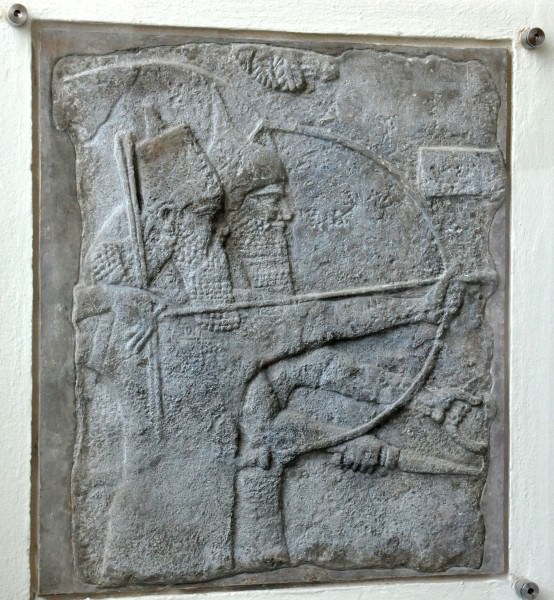
King Tiglath-pileser III holds a bow
Sennacherib's military victories increased the wealth of the empire. He moved the capital to Nineveh and built what was known as “the Palace without a Rival”. He beautified and improved upon the city's original structure, planting orchards and gardens.The historian Christopher Scarre writes,
Sennacherib's palace had all the usual accoutrements of a major Assyrian residence: colossal guardian figures and impressively carved stone reliefs (over 2,000 sculptured slabs in 71 rooms). Its gardens, too, were exceptional. Recent research by British Assyriologist Stephanie Dalley has suggested that these were the famous Hanging Gardens, one of the Seven Wonders of the Ancient World. Later writers placed the Hanging Gardens at Babylon, but extensive research has failed to find any trace of them. Sennacherib's proud account of the palace gardens he created at Nineveh fits that of the Hanging Gardens in several significant details (231).
Ignoring the lessons of the past, however, and not content with his great wealth and the luxury of the city, Sennacherib drove his army against Babylon, sacked it, and looted the temples. As earlier in history, the looting and destruction of the temples of Babylon was seen as the height of sacrilege by the people of the region and also by Sennacherib's sons who assassinated him in his palace at Nineveh in order to placate the wrath of the gods. Although they certainly would have been motivated to murder their father for the throne (after he chose his youngest son, Esarhaddon, as heir in 683 BCE, snubbing them) they would have needed a legitimate reason to do so; and the destruction of Babylon provided them with one.
ESARHADDON (681-669 BCE) SUCCESSFULLY CONQUERED EGYPT & ESTABLISHED THE EMPIRE'S BORDERS AS FAR NORTH AS THE ZAGROS MOUNTAINS.
His son Esarhaddon (681-669 BCE) took the throne, and one of his first projects was to rebuild Babylon. He issued an official proclamation which claimed that Babylon had been destroyed by the will of the gods owing to the city's wickedness and lack of respect for the divine. Nowhere in his proclamation does it mention Sennacherib or his role in the destruction of the city but makes clear that the gods chose Esarhaddon as the divine means for restoration: “Once during a previous ruler's reign there were bad omens. The city insulted its gods and was destroyed at their command. They chose me, Esarhaddon, to restore everything to its rightful place, to calm their anger, and soothe their rage.” The empire flourished under his reign. He successfully conquered Egypt (which Sennacherib had tried and failed to do) and established the empire's borders as far north as the Zagros Mountains (modern day Iran) and as far south as Nubia (modern Sudan) with a span from west to east of the Levant (modern day Lebanon to Israel) through Anatolia (Turkey). His successful campaigns, and careful maintenance of the government, provided the stability for advances in medicine, literacy, mathematics, astronomy, architecture, and the arts.Durant writes:
In the field of art, Assyria equaled her preceptor Babylonia and in bas-relief surpassed her. Stimulated by the influx of wealth into Ashur, Kalakh, and Nineveh, artists and artisans began to produce – for nobles and their ladies, for kings and palaces, for priests and temples – jewels of every description, cast metal as skilfully designed and finely wrought as on the great gates at Balawat, and luxurious furniture of richly carved and costly woods strengthened with metal and inlaid with gold, silver, bronze, or precious stones (278).
In order to secure the peace, Esarhaddon's mother, Zakutu (also known as Naqia-Zakutu) entered into vassal treaties with the Persians and the Medes requiring them to submit in advance to his successor. This treaty, known as the Loyalty Treaty of Naqia-Zakutu, ensured the easy transition of power when Esarhaddon died preparing to campaign against the Nubians and rule passed to the last great Assyrian king, Ashurbanipal (668-627 BCE). Ashurbanipal was the most literate of the Assyrian rulers and is probably best known in the modern day for the vast library he collected at his palace at Nineveh. Though a great patron of the arts and culture, Ashurbanipal could be just as ruthless as his predecessors in securing the empire and intimidating his enemies. Kriwaczek writes,
Which other imperialist would, like Ashurbanipal, have commissioned a sculpture for his palace with decoration showing him and his wife banqueting in their garden, with the struck-off head and severed hand of the King of Elam dangling from trees on either side, like ghastly Christmas baubles or strange fruit? (208).
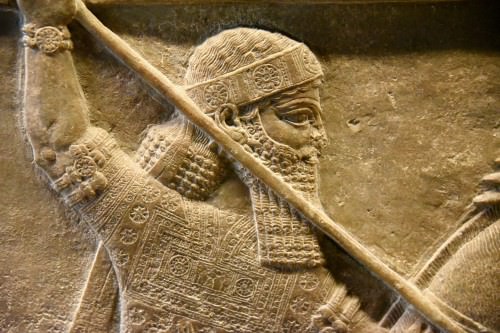
Ashurbanipal II
He decisively defeated the Elamites and expanded the empire further to the east and north. Recognizing the importance of preserving the past, he then sent envoys to every point in the lands under his control and had them retrieve or copy the books of that city or town, bringing all back to Nineveh for the royal library.
Ashurbanipal ruled over the empire for 42 years and, in that time, campaigned successfully and ruled efficiently. The empire had grown too large, however, and the regions were overtaxed. Further, the vastness of the Assyrian domain made it difficult to defend the borders. As great in number as the army remained, there were not enough men to keep garrisoned at every significant fort or outpost. When Ashurbanipal died in 627 BCE, the empire began to fall apart. His successors Ashur-etli-Ilani and Sin-Shar-Ishkun were unable to hold the territories together and regions began to break away. The rule of the Assyrian Empire was seen as overly harsh by its subjects, in spite of whatever advancements and luxuries being an Assyrian citizen may have provided, and former vassal states rose in revolt.
IN 612 BCE NINEVEH WAS SACKED & BURNED BY A COALITION OF BABYLONIANS, PERSIANS, MEDES, & SCYTHIANS.
In 612 BCE Nineveh was sacked and burned by a coalition of Babylonians, Persians, Medes, and Scythians, among others.The destruction of the palace brought the flaming walls down on the library of Ashurbanipal and, although it was far from the intention, preserved the great library, and the history of the Assyrians, by baking hard and burying the clay tablet books.Kriwaczek writes, “Thus did Assyria's enemies ultimately fail to achieve their aim when they razed Ashur and Nineveh in 612 BCE, only fifteen years after Ashurbanipal's death: the wiping out of Assyria's place in history” (255). Still, the destruction of the great Assyrian cities was so complete that, within two generations of the empire's fall, no one knew where the cities had been. The ruins of Nineveh were covered by the sands and lay buried for the next 2,000 years.
LEGACY OF ASSYRIA
Thanks to the Greek historian Herodotus, who considered the whole of Mesopotamia 'Assyria', scholars have long known the culture existed (as compared to the Sumerians who were unknown to scholarship until the 19th century CE). Mesopotamian scholarship was traditionally known as Assyriology until relatively recently (though that term is certainly still in use), because the Assyrians were so well known through the primary sources of the Greek and Roman writers. Through the expanse of their empire, the Assyrians spread Mesopotamian culture to the other regions of the world, which have, in turn, impacted cultures world-wide up to the present day. Durant writes:
Through Assyria's conquest of Babylon, her appropriation of the ancient city's culture, and her dissemination of that culture throughout her wide empire; through the long Captivity of the Jews, and the great influence upon them of Babylonian life and thought; through the Persian and Greek conquests which then opened with unprecedented fullness and freedom all the roads of communication and trade between Babylon and the rising cities of Ionia, Asia Minor, and Greece – through these and many other ways the civilization of the Land between the Rivers passed down into the cultural endowment of our race. In the end nothing is lost; for good or evil, every event has effects forever (264).
Tiglath Pileser III had introduced Aramaic to replace Akkadian as the lingua franca of the empire and, as Aramaic survived as a written language, this allowed later scholars to decipher Akkadian writings and then Sumerian. The Assyrian conquest of Mesopotamia, and the expansion of the empire throughout the Near East, brought Aramaic to regions as near as Israel and as far as Greece and, in this way, Mesopotamian thought became infused with those cultures and a part of their literary and cultural heritage. Following the decline and rupture of the Assyrian empire, Babylon assumed supremacy in the region from 605-549 BCE. Babylon then fell to the Persians under Cyrus the Great who founded the Achaemenid Empire (549-330 BCE) which fell to Alexander the Great and, after his death, was part of the Seleucid Empire.
The region of Mesopotamia corresponding to modern-day Iraq, Syria, and part of Turkey was the area at this time known as Assyria and, when the Seleucids were driven out by the Parthians, the western section of the region, formerly known as Eber Nari and then Aramea, retained the name Syria. The Parthians gained control of the region and held it until the coming of Rome in 115 CE, and then the Sassanid Empire held supremacy in the area from 226-650 CE until, with the rise of Islam and the Arabian conquests of the 7th century CE, Assyria ceased to exist as a national entity. Among the greatest of their achievements, however, was the Aramaic alphabet, imported into the Assyrian government by Tiglath Pileser III from the conquered region of Syria. Aramaean was easier to write than Akkadian and so older documents collected by kings such as Ashurbanipal were translated from Akkadian into Aramaic, while newer ones were written in Aramaic and ignored the Akkadian. The result was that thousands of years of history and culture were preserved for future generations, and this is the greatest of Assyria's legacies.
MAP
Kingdom of Magadha: Wars and Warfare › Antique Origins
Ancient Civilizations
In ancient India from the 6th century BCE onwards, the kingdom of Magadha (6th century BCE to 4th century BCE) made a mark for itself. Located in the eastern part of India in what is today the state of Bihar, it outshone other kingdoms and republics when it came to territorial expansion and control, which was the main reason and context for its incessant wars. The period of expansion and wars started from the reign of Bimbisara (543 BCE) and lasted until the fall of Dhanananda (322/321 BCE), when the Mauryans took over.
Along with Bimbisara, the main Magadha actors who screamed war were his son Ajatashatru (492 BCE - 460 BCE) and the kings Shishunaga (c. late 5th century BCE) and Mahapadma Nanda (about mid-4th century BCE). The Magadhan armies under these aggressive rulers fought pretty much like any other kingdom's army in ancient India, using the prevalent four-fold army system (chariots, infantry, cavalry and elephants), personally led by kings or princes. Forts were present and thus, siege warfare was resorted to. In many cases, intrigue was used as a means of war. The able royal leadership and the drive to expand territorially was the main reason for Magadhan success as it impacted heavily on its military system and modes of warfare. The kingdom fell when the king was weak and unpopular and his supporters lost to intrigue—it was not exactly a military defeat. Interestingly, the story of Magadhan expansion reads just like a story—complete with intrigues, scandals, murders, undercover operations and whatnot. Interestingly, it is all history.
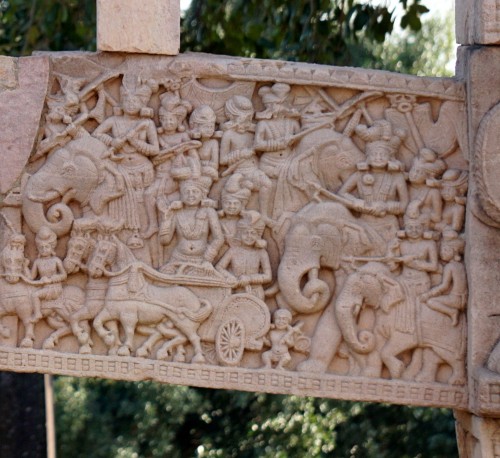
Mauryan and Pre-Mauryan soldiers from the Sanchi Stupa
POLITICAL SETTING
Magadha was one of 16 territorial units termed as mahajanapadas, which included both kingdoms and republics. Anga, Koshala (Kosala), Avanti and Vriji were those mahajanapadas geographically close to Magadha, against which this kingdom was to wage its wars. The Vriji or Vajji, was a confederacy of many clans of which the Lichcchavis were predominant. The capital was at Vaishali and it was governed by an oligarchy composed of a governing body of 7707 members, styled raja(king). Coming from different mahajanapadas, most of the royal actors in this story of expansion were contemporaries of the Buddha and had interacted with him.
WARS & EXPANSION UNDER THE HARYANKA DYNASTY
King Bimbisara
Geographically, the kingdom of Magadha had many advantages, especially in military terms. It was protected on all sides by mountains and rivers. The capital Girivraja was enclosed by five hills and stone walls. Trade and agriculture were thriving, thus providing an excellent resource base for military expeditions. A new capital Rajagriha ( Sanskrit : “royal home”) developed around Girivraja and continued to be the royal home till the shift to Pataliputra.
CROWNED AT THE AGE OF 15, BIMBISARA WAS CREDITED WITH BEGINNING MAGADHA'S TERRITORIAL EXPANSION.
King Bimbisara (543 – 492 BCE), who was also known as Shrenika or Seniya, was the son of King Bhattiya, the first king of the Haryanka dynasty. Crowned at the age of 15, he was credited with beginning Magadha's territorial expansion. His quest, or rather, his decision to go to war, was built upon Magadha's advantages as compared to its adversaries. Bimbisara first annexed Anga to the east. One of his sons Ajatashatru participated in the war with Anga. Pleased with his bravery and leadership, Bimbisara made him the viceroy upon its conquest.
However, his kingdom was not strong enough to conquer heavyweights like Koshala and Vaishali. So, Bimbisara chose a bloodless way out—he entered into matrimonial alliances with Koshala and Vaishali. From Koshala, the village of Kashi was received in the form of dowry, which yielded high revenues. Ultimately, the territory of Bimbisara came to consist of 80,000 villages and an area of 300 leagues.

The 16 Mahajanapadas, Including Magadha
King Ajatashatru
King Bimbsara's successor Ajatashatru (Sanskrit: “One whose enemies are not born”; Pali: Ajatasattu; also known as Kunika) carried on further with the schemes of expansion. His reign lasted from 492 BCE to 460 BCE. His enemies may not have been born, but were definitely created. The first on the list (according to him) was his own father, whom he deposed, imprisoned and later killed, for fear that the throne might be given to any of his half-brothers. This act brought upon Ajatashatru's first war as king. King Prasenajit (Pali: Pasenadi) (c. 6th cnetury BCE) of Koshala decided to avenge the deaths of his brother-in-law and sister, who had died of grief at Bimbisara's tragic demise. In this endeavour, he was joined by some republican mahajanapadas bordering Magadha in the north and north-west, like the Vrijis of Vaishali and Mallas of Kushinagara and Pava.
The fortress of Pataligrama was built by Magadha in defence, which within a generation developed into the city of Pataliputra, the capital of empires in India for centuries to come.
Ajatashatru used both strategy and military means to deal with his opponents. The war with Koshala began after Prasenajit took hold of Kashi and stopped its revenues from going to Magadha. The loss of revenue and loss of face made Ajatashatru prepare for a fitting reply on the battlefield. Fortune favoured both sides, with the war not coming to any conclusion for a long time, but ultimately, Magadha prevailed. Koshala humbled, Prasenajit returned Kashi (which became a part of Magadha) and offered his daughter in marriage to the conqueror.

Remains of the Jail where Bimbisara was Imprisoned
CONQUEST OF VAISHALI: WAR BY OTHER MEANS
The war with Vaishali did not prove to be a cakewalk. In need of advice, Ajatashatru decided to send a minister to seek the counsel of the wisest man living at the time—the Buddha. He stated that the Vrijis could not be conquered, as they were observing all conditions that strengthen a republic, including holding assemblies and unity of counsel and policy. Taking note of the issue of Vrijian unity, Ajatashatru decided to break it first before he did anything else. He had already noted that a unified enemy implied heavy resistance and resultant heavy losses.
As advised by one of his ministers, Varshakara (Pali: Vassakara), the Magadhan monarch pretended to have him disgraced and banished, upon which the crafty ex-minister found easy asylum in Vaishali. As per plan, within a few years, he created so much dissension and disunity among the Vrijis (especially among the members of the assembly) that they could no longer agree to help each other hold off the Magadhans! With the unified defence gone, whatever was left of their resistance was wiped out by Ajatashatru's military, which had used innovative weapons called the rathamusala (a chariot with a mace attached, causing much mayhem) and the mahashilakantaga (a siege engine resembling a huge catapult). With the fall of Vaishali, the Mallas also gave in.
IT IS HIGHLY LIKELY THAT EVEN IF WAR HAD NOT ERUPTED IN HIS FACE, AJATASHATRU WOULD HAVE ACTIVELY SOUGHT IT.
The accounts say that the war with Vaishali dragged on for 16 long years (484 – 468 BCE). The initial reverses received thus caused Ajatashatru to rethink his strategy and focus on breaking the Vrijis from within, while coming up with new, more radical weaponry.
The conquest in Ajatashatru's time ended with Vaishali being annexed. The accounts say that one cause of the war with Vaishali was Ajatashatru's pursuit of his fleeing brothers Halla and Vehalla, They had taken with them certain prized objects and had been given shelter by the Lichchhavis who refused to surrender them. Whatever the case, political ambition was clearly dominating Ajatashatru's mind. He had after all, not deposed (killed!) his father for nothing, and had conveniently ignored his father's cordial and family relations with Koshala and Vaishali (according to the accounts, his own mother, Bimbisara's second wife, was the daughter of one of the chieftains of Vaishali). It is highly likely that even if war had not erupted in his face, Ajatashatru would have actively sought it.

Magadhan and Mauryan Soldiers
A major characteristic of the wars waged by Ajatashatru were that both were long-drawn-out affairs, with no quick conclusions or no single decisive battlefield victory that could decide the outcome of the war. This also points to the military capabilities of his opponents, and that at this time, Magadha was not militarily superior. This superiority was slowly, and painfully, built.
Ajatashatru also began fortifying his capital against an invasion from Avanti, which did not happen. His son Udayin (aka Udayi or Udayibhadra), who succeeded him in 459 BCE, fought with Avanti, but not many details are available. Earlier, he had founded the strategically situated city of Pataliputra. The last rulers of this dynasty were not so efficient and the last was ultimately replaced by a new dynasty of the Shaishunagas.
WARS & EXPANSION UNDER THE SHAISHUNAGAS & NANDAS
The first king, Shishunaga(c. late 5th century BCE), continued the forward policy by absorbing Avanti, thereby ending its dynastic rule of the Pradyotas (which were not heard of again in Indian history). This victory handed to Shishunaga the territories of Madhyadesha, Malwa and many others in North and Central India, and removed the only serious enemy it had at the time.
The last ruler of this dynasty was murdered, and with no credible succession to take place, a new king called Mahapadma Nanda took over about the middle of the fourth century BCE, ushering the reign of the last dynasty before the Mauryans took over the reigns of power in Magadha.

“War over the Buddha’s Relicsâ€, Sanchi
Pali works refer to Mahapadma as Ugrasena because of his huge army. His conquests enabled Magadha to stretch its boundaries much further (Koshala was annexed), with the result that by the time of Dhanananda (329 - 322/21 BCE), the last ruler of the dynasty, the kingdom possessed a vast treasure, and an army numbering 20,000 cavalry, 200,000 infantry, 2,000 chariots and 3,000 elephants, as according to the Roman hostorian Curtius (1st century CE).
Dhanananda was a contemporary of Alexander the Great (356 - 323 BCE), who invaded India in 326 BCE, and was known to the Greeks as Xandrames or Agrammes. It was the knowledge of this Magadhan might that had added to the despair of the already war-weary Macedonian troops in India's north-west, forcing them, among other reasons, not to press further into India.
Magadha's expansion was to resume under the Mauryas, after Chandragupta Maurya (322/21 - 297 BCE) overthrew Dhanananda. The Kingdom of Magadha thus laid the foundation of India's first subcontinental empire.
MAGADHA DECLINE
The Nanda rule ended about 322 – 321 BCE. Dhanananda's mighty army and power could keep his critics in check, but do nothing to improve his popularity among his subjects (who had issues with heavy taxation and the personality of the ruler).However, a scholar called Vishnugupta Chanakya or Kautilya (c. 4th century BCE) decided to take radical action in order to avenge his humiliation at the hands of the king.
He enabled his protégé Chandragupta Maurya (Sandrakottos to the Greeks) to raise a huge and formidable army and challenge Nanda authority. Dhanananda lost, and it is quite interesting to see how. No matter what Chandragupta's military might was, there were (again!) lots of intrigues, counter-intrigues, plotting and counter-plotting which Kautilya resorted to in order to break the strength of Dhanananda by weaning away his key allies, loyalists and supporters. The Sanskrit drama Mudrarakshasa, written by Vishakhadatta somewhere between 4th to 8th centuries CE (presumably 5th century CE) gives vivid details of the same.
Chandragupta took over the throne at Pataliputra and became the first Maurya ruler. With Dhanananda's popularity ratings being abysmal, the new king (and later emperor) was happily accepted. The kingdom of Magadha had passed into history.
WARFARE IN THE PERIOD
Army Organization
The Magadha army was composed of four arms ( chaturanga ):
- infantry
- cavalry
- chariots
- elephants
They were all deployed in the field of battle in formation, as decided by the commanders, based on factors such as the nature of the terrain and the composition of one's own and the enemy's forces. Great concern was shown to the training of men and animals. Sham fights would be organized and the army deployed in battles which were then reviewed.

Royal Procession Leaving Rajagriha
The kings and princes were well-trained in the arts of war and leadership. They were expected to display courage and often personally led their armies and participated in the defence of forts. The Buddhist texts mention Prasenajit capturing Ajatashatru after Magadha lost a battle, but then setting him free, believing that he would call off hostilities (he, of course, went the whole mile till he won).
The senapati or the commander of the army was the most important military official after the king. The chief ministers also occasionally marched with the army.
The army was a standing one, ie, recruited, trained and equipped by the state. The body of officials known as mahamatras ran the department of war. There are references to spies, local guides, labour and even naval developments. The last would have been useful to Magadha due to the rivers which surrounded or flowed through it.
Divisions of the Army
Infantry was given importance and this was the arm where maximum numbers were concentrated. Besides the normal battle formations, the footsoldiers fought also where the other divisions of the army could not be used because of geographical limitations, ie, in forests, hilly and inaccessible regions.
KING BIMBISARA PLACED A GREAT RELIANCE ON HIS WAR ELEPHANTS TO WIN HIS BATTLES.
The cavalry fought as a body on the battlefield and was deployed as such. It was an important arm and princes and kings were expected to know how to handle horses. The tasks of the horsemen included cutting off provisions and reinforcements of the enemy, scouting and reconnaissance, besides charging the enemy especially at the flanks and the rear, protecting other units of the army and covering advances and retreats and pursuing the retreating enemy.
Chariots, though used, were not as important as they had been in the earlier periods, and more stress was given to cavalry and elephants. The horses were procured from the best of places, especially northern India (the region known as Uttarapatha).

Magadhan and Mauryan Arms and Armour
Bimbisara placed a great reliance on his war elephants to win his battles. The elephants were employed in battle in a block or a line. Otherwise, they cleared the way for marches and forded the rivers that lay in their paths, guarded the army's front, flanks and rear and battered down the walls of the enemy. However, they could frequently become uncontrollable when wounded, and caused more damage than good. Yet, they remained the mainstay of Indian armies for centuries afterwards as well (compared to their advantages, the elephants' backfiring talents were quite overlooked).
Forts, Fortifications & Siege Warfare
Forts were built, attacked and defended. They had permanently stationed garrisons with a proper division of their functions.The Buddhist Pali sources give a list of such officers and troops, which include:
- billeting officers ( chalaka )
- soldiers of the supply corps ( pindadayika )
- stormtroopers ( pakkhandino )
- warriors in leather cuirasses ( cammayodhino )
The dovarika or gatekeeper was seen as an intelligent and responsible officer as he opened the gate only to trusted and well-known people, keeping out strangers and men of dubious credentials. There are references to the capital of Anga having a gate, walls and watchtower.
Weapons
The equipment of the infantry included arms as well as armour. Arms included:
- bows and arrows
- swords
- shields (often of hides)
- javelins
- lances
- axes
- pikes
- clubs
- maces
The archers did not carry any shields, as their hands were already full with bows and arrows. The Buddhist texts refer to infantrymen with arrows in their hands ( sarahattha ). Some of the infantrymen carried conches, drums, cymbals, horns and such other musical instruments.
A good example of the soldiers' equipment in Magadha under Nanda rule can be deduced by what ancient writers had to say on military equipment of other kingdoms in India. With some regional difference that is quite probable, it is possible that Dhanananda's soldiers possessed similar equipment to that being used by north-western Indians who faced Alexander, as they were contemporaries.
The Greek historian Arrian (c. 86/89 – c. after 146/160 CE) gives some information here. The Indians fighting Alexander carried huge bows which were of equal length with the man who bore it, which he rested on the ground and pressed one of its ends with the left foot before releasing the arrow. The soldiers carried long bucklers of undressed ox-hide, javelins and broadswords wielded double-handed. The cavalry carried two lances and a buckler (round shield), smaller than the infantry one.
Arrian believed that even the archers carried shields, but no such evidence is given by the sculptures of Bharhut and Sanchi stupas that furnish the earliest visual evidence of a footsoldier's equipment in ancient India. Though created under Mauryan (and post-Mauryan) rule after the period under discussion, these sculptures are a good showcase of what the soldiers would have looked like in Magadha and other janapadas, since the Mauryas had succeeded the Nandas, the last Magadhan dynasty, and therefore would have carried on the same patterns of warfare and equipment as the base of their own military system, with some additions and subtractions. It is also quite probable that Magadhan archers may not have carried shields which could have been the prevalent practice in the north-west—a proof of regional differences in arms and armour within India.
Armour
In many cases, the soldiers could have been bare to the waist, owing to custom, heat or simply lack of equipment. This seems to be the case for the lowest class of soldiers, with the elites commanding the army or other officials being adequately provided for (especially with metal armour), along with some other classes of troops that could be similarly well-furnished.
But wherever they were equipped well, soldiers preferred quilted cotton jackets (owing to the high temperature in summers, it was seen as creating more comfort than metal or leather armour). Sculptures made in the Mauryan period, like those adorning the Sanchi stupa, show soldiers wearing thickly coiled turbans, often secured with scarfs tied below the chin, and bands of cloth tied across their waists and chests as protective armour.

Magadha Kingdom
The lower garment was a loose cloth worn as a kilt or in the drawer style (one end of the garment drawn between the legs and tucked in the waist at the back). Alternatively, metal and chainmail armour is mentioned in the literature of the Vedic and Epic periods that preceded the Magadhan conquests, and thus may have been in use at this point in time also (though not very frequently).
Different terminologies were used to denote different pieces of armour covering different body parts, ie, shirastrana (cover for the head, including the above-mentioned turban), kanthatrana (cover for the neck), kurpasha (cover for the trunk), kanchuka (a coat extending as far as the knee joints), varavana (a coat extending as far as the heels), patta (a coat without cover for the arms), and nagodarika (gloves). There were also armours made from hides, hoofs and horns of certain animals like tortoise, rhinoceros, bison, elephant or cow.
LEGACY
Magadha became the base for the imperial rule ushered in by the Mauryas (324/321-187 BCE). Being a student and later teacher at Takshashila, Kautilya was witness to the political turmoil created in north-western India because of the Macedonian invasion. This caused him to think in terms of establishing a centralized pan -Indian empire that could keep invaders at bay and restore order. The existence of numerous republics and kingdoms, disunited and perennially at war with each other, for obvious reasons, could not do so.
He considered Magadha apt to be the empire in question—his proposal for the same was met by scorn and insults from Dhanananda, which was followed by Kautilya's determination to remove the incumbent king and the eventual takeover by Chandragupta. What is important here is that Magadha was thus the only territorial entity that could provide order among the chaos. It had a virtually unrivalled military standing, crucial for the existence of the kind of empire that Kautilya wanted.Protected by its vast military, it enjoyed a stability that other kingdoms could not. Kautilya was thus determined to have Magadha as the centrepiece of his scheme of things—whether under the Nandas or someone else, it did not matter. Hence, he encouraged Chandragupta to take over.
Though Magadha was beaten less in war and more in intrigue by Kautilya, it became a redundant issue. The significant issue was the reason for the wily scholar's challenge to the Nandas. What Magadha meant was of importance and as we have seen, this in a large measure was due to the handiwork of Bimbisara and those who succeeded him. Needless to say, it was about all the wars they had waged. Their way of war and warfare provided a sound basis to the Mauryan military and its subsequent conquests. It is that legacy that became enshrined in the Arthashastra written by Kautilya, which even to this day, remains the prime text for studying the concept of war in India. It is also, unsurprisingly, a key text when it comes to understanding intrigue as a means of warfare.
LICENSE:
Article based on information obtained from these sources:with permission from the Website Ancient History Encyclopedia
Content is available under License Creative Commons: Attribution-NonCommercial-ShareAlike 3.0 Unported. CC-BY-NC-SA License